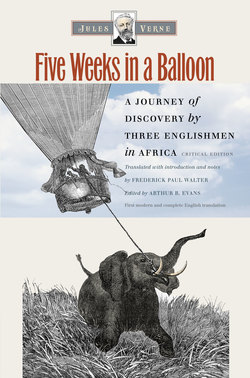Читать книгу Five Weeks in a Balloon - Jules Verne - Страница 12
На сайте Литреса книга снята с продажи.
Оглавлениеchapter 2
An article in the Daily Telegraph—scholarly journals at war—Herr Petermann stands by his friend Dr. Fergusson—response from the learned Koner—sporting wagers—various propositions made to the doctor.
The next day, in its January 15 issue, the Daily Telegraph published an article that read as follows:
At last Africa is going to turn over the secrets of her vast, lonely wastes: a modern-day Oedipus will be giving us the key to a riddle that the scholars of sixty centuries haven’t managed to decipher. Formerly, to search for the source of the Nile—or, in the old Latin wording, fontes Nili quærere—was viewed as an insane endeavor, a fantasy that could never become reality.
Dr. Barth followed the route plotted by Denham and Clapperton as far as Sudan; Dr. Livingstone conducted many courageous investigations from the Cape of Good Hope to the Zambezi basin; Captains Burton and Speke discovered the great inland lakes. They blazed three trails for modern civilization; the spot where they intersect—which travelers still haven’t managed to reach—lies in Africa’s very heart. It’s in this region that every effort needs to be made.
Now the deeds of those bold scientific pioneers will be tied together in this daring endeavor by Dr. Samuel Fergusson, whose splendid feats of exploration our readers have often relished.
This courageous discoverer1 proposes to cross all Africa from east to west by balloon. If our sources are correct, the starting point of this astounding journey will be the island of Zanzibar off Africa’s east coast. As for its endpoint, God only knows.
Yesterday the Royal Geographical Society heard a formal proposal for this piece of scientific exploration; they approved the sum of £2500 to cover the undertaking’s costs.
We will keep our readers up to date on this endeavor, which is unprecedented in the annals of geography.
As you might expect, this article had an enormous impact: at first it stirred up storms of skepticism; folks regarded Dr. Fergusson as an outright fantasy, an invention of Mr. P. T. Barnum—who, after working the states of the Union, was all set to “take in” the British Isles.
In Geneva a witty rebuttal appeared in the February issue of Dispatches from the Geographical Society; it poked fun at London’s Royal Society, the Travelers Club, and the phenomenal sturgeon.
But Herr Petermann’s Mitteilungen,2 published in Gotha, reduced the Geneva journal to the most abject silence. Herr Petermann was personally familiar with Dr. Fergusson and vouched for the bravery of his daring friend.
Soon, however, there was no longer any room for doubt; preparations for the journey were under way in London; the factories of Lyon had received a major order for the taffeta needed to manufacture the lighter-than-air vehicle; lastly the British government put the cargo boat Resolute, skippered by Captain Pennet, at the doctor’s disposal.
Instantly thousands offered him encouragement, thousands bombarded him with congratulations. Meanwhile details of the undertaking were published in the bulletins of the Paris Geographical Society; a notable article appeared in Monsieur V. A. Malte-Brun’s New Annals of Travel, Geography, History, and Archaeology; a probing piece by Dr. W. Koner saw print in the Zeitschrift für Allgemeine Erdkunde,3 triumphantly revealing the journey’s potential, its chances of success, the nature of the obstacles ahead, the immense advantages of an airborne mode of travel; it criticized only the journey’s starting point; instead it preferred Massawa, a little Ethiopian port from which James Bruce had set out in 1768 to search for the Nile’s headwaters. But it unreservedly admired Dr. Fergusson’s strength of mind and the bold-as-brass courage that could conceive and attempt such a journey.
The North American Review watched with little pleasure as England basked in all this glory; it laughed off the doctor’s proposal and invited him to push on to America while the going was good.
In short, without listing every periodical on the planet, there wasn’t a scientific forum from the Journal of Evangelical Missions to the Algerian and Colonial Review, from the Annals of the Propagation of the Faith to the Church Missionary Reporter, that didn’t go into every aspect of this affair.
In London and across England, folks wagered sizable sums: 1) on whether Dr. Fergusson was a real or imaginary being; 2) on the journey itself, which some said wouldn’t even be attempted and others said would be carried out in full; 3) on the issue of determining if it succeeded or not; 4) on the likelihood or unlikelihood of Dr. Fergusson ever coming back. The bookmakers logged enormous amounts on these wagers, as if they were taking bets at Epsom Downs.
As a consequence, believers, skeptics, dunces, and scholars all kept their eyes on the doctor; he became the lion of the day, without ever suspecting that he sported a mane. He was happy to provide detailed information on his expedition. He was easy to approach and the most straightforward fellow on earth. More than one bold adventurer turned up, eager to share in the glory and dangers of his endeavor; but the doctor refused without giving any reasons for his refusal.
Many inventors of gadgets devised for steering balloons came and proposed their methods to him. He wasn’t in the market. To anybody who asked if he himself had discovered something of the sort, he consistently refused to elaborate and became more energetically involved than ever in the preparations for his journey.
